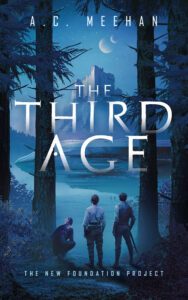A few people have commented on the number of characters in A Signal for Redemption, which apparently seems high to some readers. They’ve shared that feedback as a mix of observation and complaint, and I get it. Keeping track of who’s who can be a challenge and there’s a risk that a reader won’t be able to connect to the right character in the confusion. How many is too many?
For people who are writing marketable books, there are different best-practice answers for different genres. The same advice sites that provide maximum word counts and offer suggestions for finding niches have rules of thumb for character counts. Probably good advice, but I have my own answer, based on the fact that real life is crowded.
I’ve been meeting a lot of people lately. Various “experts” have tried to figure out how many people the average person knows. It’s an interesting but pretty much unanswerable question, starting from the problem with the myth of the Average Person. And meeting people is different from knowing people, but some of the research and estimates I came across didn’t distinguish. So a grain of salt won’t suffice here—I think access to the salt mine would be helpful—but estimates range from knowing 600 people to meeting 80,000 over a lifetime. Our lives are full of other people.
(Other research suggests that most of us can recall about 5,000 faces, though not always with names. To the 75,000 people I will not remember ever seeing before, I apologize. It’s nothing personal. Hopefully none of you are people I met last week.)
All the recent introductions made me think, too, of all the “characters” from my previous job and city that I won’t see often or at all anymore. Each episode of life has a new extended cast and a universe of new extras, which is why the people who move through life with you are so treasured. I feel like the research is a little more solid on the average number of close friends, which seems to consistently be found to be 3-5.
However, fiction has its own rules, and I’ve been asking myself if I’m right to include so many named people in my stories.
I have four viewpoint characters in Signal and well over twenty bit players. For some readers, that feels like a lot. Maybe even too many. Some of those same readers have told me that the world of Signal feels real, though, and I think it’s related.
The tight viewpoints of the four leading characters are meant to create a bond with the reader. The goal is for those characters to feel three-dimensional and like they have life beyond the story. The reader has a chance to share their experiences, as friends do.
In theory, the whole story could be told just through their perspective. Everyone else in the story could be like extras in the movies, not much more than human scenery. But real people have many layers of social life, with a few close friends, a wider circle of casual friends, and then concentric rings of daily contacts, transient connections, and background communities.
I believe viewpoint characters feel more authentic when they operate in a fully realized social environment. Other people shape who we are. Acknowledging that every person—every character—has independent perspective and experience creates richer interactions. When a reader experiences those richer interactions through the viewpoint character’s eyes, it makes the story world feel a lot more realistic.
So yes, I could pare the list of sidekicks and extras. If I were focused on the story rather than the characters, maybe I would. If I wanted to keep the story world simple, certainly I would. And if I were writing something to have a chance at a best-seller list, no doubt I should. But I probably won’t, because part of what matters to me in these stories is the human experience. And real life is crowded.
It just means finding ways to help readers stick close to the viewpoint characters without getting lost in the crowd. More on that next time.




